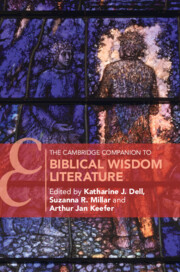Book contents
- The Cambridge Companion to Biblical Wisdom Literature
- Cambridge Companions to Religion
- The Cambridge Companion to Biblical Wisdom Literature
- Copyright page
- Contents
- Contributors
- Acknowledgement
- Abbreviations
- Part I The Context of Wisdom Literature
- 1 Introduction
- 2 The Scope of Wisdom Literature
- 3 The Multiple Genres of Wisdom
- 4 The Literary Context(s) and Development of Wisdom Literature in Ancient Israel (with Special Reference to Proverbs)
- 5 The Scribal World
- 6 Theological Themes in the ‘Wisdom Literature’
- 7 The Solomonic Connection
- Part II Wisdom Literature in the Hebrew Bible
- Part III Wisdom Literature beyond the Hebrew Bible
- Part IV Themes in the Wisdom Literature
- Bibliography
- Index
- Cambridge Companions to Religion
- References
5 - The Scribal World
from Part I - The Context of Wisdom Literature
Published online by Cambridge University Press: 28 July 2022
- The Cambridge Companion to Biblical Wisdom Literature
- Cambridge Companions to Religion
- The Cambridge Companion to Biblical Wisdom Literature
- Copyright page
- Contents
- Contributors
- Acknowledgement
- Abbreviations
- Part I The Context of Wisdom Literature
- 1 Introduction
- 2 The Scope of Wisdom Literature
- 3 The Multiple Genres of Wisdom
- 4 The Literary Context(s) and Development of Wisdom Literature in Ancient Israel (with Special Reference to Proverbs)
- 5 The Scribal World
- 6 Theological Themes in the ‘Wisdom Literature’
- 7 The Solomonic Connection
- Part II Wisdom Literature in the Hebrew Bible
- Part III Wisdom Literature beyond the Hebrew Bible
- Part IV Themes in the Wisdom Literature
- Bibliography
- Index
- Cambridge Companions to Religion
- References
Summary
Mark Sneed introduces readers to the world of scribes. Drawing first on some of the earliest developments of Sumerian scribalism, he gives an overview of how scribes trained and worked in the ancient Near East more broadly. In Egypt and elsewhere, scribal training began at an early age and involved a wide range of curricula, including wisdom literature, which scribes copied and memorized, as it played a significant role in scribal education. Although concrete evidence for Israelite schools is lacking, Sneed finds reason to believe that similar scribal practices existed there, where wisdom literature too served technical and ethical purposes. Scribes, then, existed in ancient Israel, and for Sneed could be identified in various ways: priests, prophets, and sages. Behind each of these lies the “scribe” as one who composed the texts themselves. Thus Sneed finds far more that is common than different among the biblical materials, wisdom texts included, and conceives of the scribe as holding a wide-ranging professional role in Israel that was not tied down to a single genre of literature.
- Type
- Chapter
- Information
- The Cambridge Companion to Biblical Wisdom Literature , pp. 76 - 95Publisher: Cambridge University PressPrint publication year: 2022

